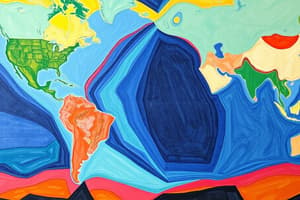Podcast
Questions and Answers
The theory of ______________ ______________ says that Earth's outer layer is made up of large, moving pieces called plates.
The theory of ______________ ______________ says that Earth's outer layer is made up of large, moving pieces called plates.
plate tectonics
____________________________ is when oceanic plates collide, one of those plates will go beneath the other.
____________________________ is when oceanic plates collide, one of those plates will go beneath the other.
subduction
At a __________ plate boundary new crust is created as two or more plates pull away from each other.
At a __________ plate boundary new crust is created as two or more plates pull away from each other.
divergent
A -__ ____________ is an underwater mountain system formed by plate tectonics.
A -__ ____________ is an underwater mountain system formed by plate tectonics.
________________________ _____________________ are places where plates slide sideways past each other.
________________________ _____________________ are places where plates slide sideways past each other.
When tectonic plates slide past each other a __________ is formed.
When tectonic plates slide past each other a __________ is formed.
A __________ ____________________ occurs when two tectonic plates collide into each other.
A __________ ____________________ occurs when two tectonic plates collide into each other.
A ____________________ is a deep depression of the sea floor caused by the subduction of one plate under another.
A ____________________ is a deep depression of the sea floor caused by the subduction of one plate under another.
Movements within Earth's mantle that causes tectonic plates to collide, separate, or slide past each other are called __________ __________.
Movements within Earth's mantle that causes tectonic plates to collide, separate, or slide past each other are called __________ __________.
The ____________________ is a layer between the crust and the outer core.
The ____________________ is a layer between the crust and the outer core.
In many locations the hot molten magma from deep within the Earth rises up through the crust to reach the surface called a ____________ ____________.
In many locations the hot molten magma from deep within the Earth rises up through the crust to reach the surface called a ____________ ____________.
Flashcards are hidden until you start studying
Study Notes
Plate Tectonics Overview
- Plate tectonics theory explains the Earth's outer layer consists of large, mobile pieces called plates.
- Tectonic activities shape the Earth's landscape, causing earthquakes, volcanic eruptions, and mountain formation.
Subduction
- Subduction refers to the process where one oceanic plate descends beneath another during a collision, leading to geological phenomena like trenches and volcanic arcs.
Divergent Boundary
- At a divergent plate boundary, tectonic plates move apart, resulting in the formation of new crust, often found at mid-ocean ridges.
Mid-Ocean Ridge
- A mid-ocean ridge is an underwater mountain range constructed by volcanic activity, marking the sites of divergent boundaries and new crust formation.
Transform Boundary
- Transform boundaries occur when tectonic plates slide past each other horizontally, often leading to earthquakes as stress builds up along faults.
Fault Formation
- A fault is created when tectonic plates move laterally against each other, resulting in fractures in the Earth's crust that can cause seismic events.
Convergent Boundary
- Convergent boundaries are formed when two plates collide, resulting in geological features like mountains, trenches, or volcanic arcs depending on the plate types involved.
Trench
- A trench is a deep, elongated depression in the ocean floor formed by the subduction of one tectonic plate beneath another, often associated with intense geological activity.
Convection Currents
- Convection currents in the Earth's mantle drive the movement of tectonic plates, caused by heat from the core creating dynamic circulation that results in plate interactions.
Mantle
- The mantle is the thick layer of semi-solid rock situated between the Earth's crust and the outer core, playing a crucial role in tectonic activity and heat transfer.
Hot Spot
- A hot spot is a location where molten magma from the Earth's interior rises to the surface, forming volcanic features independent of tectonic plate boundaries, often resulting in islands like Hawaii.
Studying That Suits You
Use AI to generate personalized quizzes and flashcards to suit your learning preferences.




